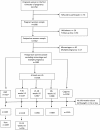Determining gestational age for public health care users in Brazil: comparison of methods and algorithm creation
- PMID: 23402277
- PMCID: PMC3585703
- DOI: 10.1186/1756-0500-6-60
Determining gestational age for public health care users in Brazil: comparison of methods and algorithm creation
Abstract
Background: A valid, accurate method for determining gestational age (GA) is crucial in classifying early and late prematurity, and it is a relevant issue in perinatology. This study aimed at assessing the validity of different measures for approximating GA, and it provides an insight into the development of algorithms that can be adopted in places with similar characteristics to Brazil. A follow-up study was carried out in two cities in southeast Brazil. Participants were interviewed in the first trimester of pregnancy and in the postpartum period, with a final sample of 1483 participants after exclusions. The distribution of GA estimates at birth using ultrasound (US) at 21-28 weeks, US at 29+ weeks, last menstrual period (LMP), and the Capurro method were compared with GA estimates at birth using the reference US (at 7-20 weeks of gestation). Kappa, sensitivity, and specificity tests were calculated for preterm (<37 weeks of gestation) and post-term (>=42 weeks) birth rates. The difference in days in the GA estimates between the reference US and the LMP and between the reference US and the Capurro method were evaluated in terms of maternal and infant characteristics, respectively.
Results: For prematurity, US at 21-28 weeks had the highest sensitivity (0.84) and the Capurro method the highest specificity (0.97). For postmaturity, US at 21-28 weeks and the Capurro method had a very high sensitivity (0.98). All methods of GA estimation had a very low specificity (≤0.50) for postmaturity. GA estimates at birth with the algorithm and the reference US produced very similar results, with a preterm birth rate of 12.5%.
Conclusions: In countries such as Brazil, where there is less accurate information about the LMP and lower coverage of early obstetric US examinations, we recommend the development of algorithms that enable the use of available information using methodological strategies to reduce the chance of errors with GA. Thus, this study calls into attention the care needed when comparing preterm birth rates of different localities if they are calculated using different methods.
Figures
Similar articles
-
Can the date of last menstrual period be trusted in the first trimester? Comparisons of gestational age measures from a prospective cohort study in six low-income to middle-income countries.BMJ Open. 2023 Sep 20;13(9):e067470. doi: 10.1136/bmjopen-2022-067470. BMJ Open. 2023. PMID: 37730415 Free PMC article.
-
Improving preterm newborn identification in low-resource settings with machine learning.PLoS One. 2019 Feb 27;14(2):e0198919. doi: 10.1371/journal.pone.0198919. eCollection 2019. PLoS One. 2019. PMID: 30811399 Free PMC article.
-
Determining gestational age and preterm birth in rural Guatemala: A comparison of methods.PLoS One. 2018 Mar 19;13(3):e0193666. doi: 10.1371/journal.pone.0193666. eCollection 2018. PLoS One. 2018. PMID: 29554145 Free PMC article.
-
Influence of different methods for calculating gestational age at birth on prematurity and small for gestational age proportions: a systematic review with meta-analysis.BMC Pregnancy Childbirth. 2023 Feb 11;23(1):106. doi: 10.1186/s12884-023-05411-0. BMC Pregnancy Childbirth. 2023. PMID: 36774458 Free PMC article.
-
Assessing the diagnostic accuracy of postnatal clinical scoring methods and foot length measurement for estimating gestational age and birthweight of newborns in low- and middle-income countries: a systematic review and meta-analysis.BMJ Paediatr Open. 2024 Aug 30;8(1):e002717. doi: 10.1136/bmjpo-2024-002717. BMJ Paediatr Open. 2024. PMID: 39214548 Free PMC article.
Cited by
-
Self-assessment of eligibility for early medical abortion using m-Health to calculate gestational age in Cape Town, South Africa: a feasibility pilot study.Reprod Health. 2016 Apr 16;13:40. doi: 10.1186/s12978-016-0160-x. Reprod Health. 2016. PMID: 27084750 Free PMC article.
-
Gestational age: comparing estimation methods and live births' profile.Rev Bras Epidemiol. 2023 Feb 20;26:e230016. doi: 10.1590/1980-549720230016. eCollection 2023. Rev Bras Epidemiol. 2023. PMID: 36820753 Free PMC article.
-
Skin thickness as a potential marker of gestational age at birth despite different fetal growth profiles: A feasibility study.PLoS One. 2018 Apr 26;13(4):e0196542. doi: 10.1371/journal.pone.0196542. eCollection 2018. PLoS One. 2018. PMID: 29698511 Free PMC article.
-
References of birth weights for gestational age and sex from a large cohort of singleton births in cameroon.Obstet Gynecol Int. 2014;2014:361451. doi: 10.1155/2014/361451. Epub 2014 May 12. Obstet Gynecol Int. 2014. PMID: 25161667 Free PMC article.
-
Pragmatic criteria of the definition of neonatal near miss: a comparative study.Rev Saude Publica. 2017 Dec 4;51:111. doi: 10.11606/S1518-8787.2017051006587. Rev Saude Publica. 2017. PMID: 29211204 Free PMC article.
References
-
- WHO. Home-based maternal records. Guidelines for development, adaptation and evaluation. World Health Organization, Geneva; 1994.
Publication types
MeSH terms
LinkOut - more resources
Full Text Sources
Other Literature Sources



